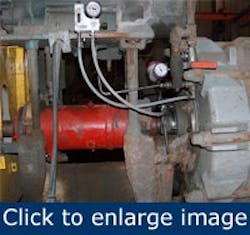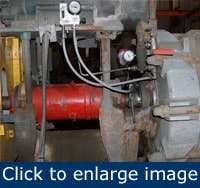Custom-designed slurry pump seals slash maintenance and downtime
The Xstrata-Copper Kidd Metallurgical Plant site, called the Met Site, near Timmins, Ontario, refines about 1% to 2% of the world’s copper and zinc production plus other related products. The operation consists of a concentrator, a copper refinery, a copper smelter and a zinc plant. It produces about 131,000 tons of copper, 140,000 tons of zinc and about 540,000 tons of sulfuric acid annually.
[pullquote]In 1990, the plant installed four ITT/AC, SRL, C-HD, Size 8x10-21 rubber-lined slimes thickener tailings pumps in the concentrators tailings pump house to pump thickened slimes tailings from the thickener through the tailings distribution lines. The pumps were originally supplied with packed stuffing box assemblies.
The Stage #1 pump receives tailings slimes from the tailings thickener at a static-head pressure of 30 psig to 50 psig, depending on the level of the tank from which this pump draws. It discharges at 60 psig to 80 psig into the Stage #2 pump, which discharges to the tailings pond at 100 psig to 190 psig.
For 18 years, the plant endured recurring pump failures that led to significant maintenance, downtime and clean-up costs. It was almost impossible to control stuffing box gland water spray, which leads to pump barrel oil contamination and oil lip seal deterioration. In the end, premature barrel failures combined with gland water control deficiencies, gland follower stud failures and rapid sleeve wear made this a poor pump application.
In addition, the pressure of the gland water injected to lubricate the braided packing and prevent the abrasive solids from entering the stuffing box often would drop too low and destroy the braided packing. Then, the slimes tailings spilled out of these stuffing boxes and onto the floor. If left undetected, the operators could find a two-foot to three-foot depth of slimes tailings on the pump house floor.
“During these upset conditions, other motors and instrumentation were frequently contaminated if they happened to be in the way of the flood,” explains Hans Bekeschus, senior technical sales representative, Northern Ontario, for Flowserve’s Flow Solutions Division. “The tailings pump house is approximately two miles away from the concentrator plant, and an operator would only travel to the tailings pump house once every eight-hour shift by truck to inspect,” adds Bekeschus. The plant repacked the pumps every two to three weeks and replaced the pump shaft sleeves about every three months.
Fitting high-pressure slimes thickener tailings pumps with custom-engineered mechanical seals increased MTBF from three weeks to indefinite.
Larry Robichaud, maintenance millwright team leader at Xstrata-Copper, knew Flowserve was supplying other types of mechanical seals in Xstrata-Copper plant sites on less severe applications and had them evaluate the tailings pumps.
The Flowserve team determined that a custom-engineered Flowserve 3.750-inch SLC, GRP.3 single-cartridge heavy-duty slurry-type mechanical seal would be the appropriate solution. “We were originally planning to supply the SLC slurry seal without the need of an external source of clean, high-pressure flush water,” Bekeschus says. “But a sample taken of their slimes solids tailings revealed that 80% were less than 40 microns in particle size.”
The Flowserve team realized that a reliable supply of high-pressure flush water was going to be required, so they designed a custom solution: a high-chrome iron bell housing with a close-clearance, glass-filled PTFE throat bushing and a specially designed pump shaft sleeve. This design prevents the slimes tailings from entering into the SLC seal’s cavity by injecting the very same external supply of flush water pressure previously used on their packed stuffing boxes. The pump motor is on a time delay, so the pressurized flush water is turned on 30 seconds before the motor and pump start.
Robichaud championed the cause and management personnel purchased and tested the first Flowserve SLC seal for the high-pressure Stage #2 slimes tailings pump. “Some people were hesitant about investing money in a mechanical seal in a slurry pump application, especially because we were dealing with the tailings. No part of that product that brings in revenue for the company,” Robichaud adds.
The first mechanical seal was installed on March, 2008 and the second in September, 2008. “In the 10 months since the first Flowserve SLC seal has been in operation, we’ve had no leakage — not even water at the gland,” Robichaud says. “That in itself is worth a lot to us.” He says both pumps continue to operate leak-free.
“We’ve eliminated the maintenance cost, lost time and production losses that occurred every time the braided packing failed and the floors needed to be cleaned,” Robichaud continues. “Contamination into the pumps barrel has been eliminated, and the quality of oil in the barrel is the same since day one of the Flowserve SLC seal’s installation.” In addition, eliminating leaks and spills has improved Xstrata-Copper’s contribution to a clean environment.

